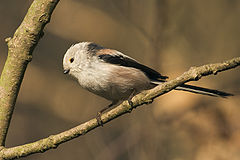
Long-tailed Tit
Did you know...
SOS believes education gives a better chance in life to children in the developing world too. A quick link for child sponsorship is http://www.sponsor-a-child.org.uk/
| Long-tailed Tit | |
|---|---|
 |
|
| Conservation status | |
|
Least Concern
|
|
| Scientific classification | |
| Kingdom: | Animalia |
| Phylum: | Chordata |
| Class: | Aves |
| Order: | Passeriformes |
| Family: | Aegithalidae |
| Genus: | Aegithalos |
| Species: | A. caudatus |
| Binomial name | |
| Aegithalos caudatus (Linnaeus, 1758) |
|
The Long-tailed Tit, Aegithalos caudatus, is a very small passerine bird. It breeds in most of Europe and Asia. It is usually a non-migratory species, although there have been several extralimital records, and migration has been observed in North-eastern Europe.
It is closely related to the true tits, and in the winter it is often found with tit flocks.
This is a very small bird at only 13–15 cm in length including its very long tail, which itself makes up 7–9 cm of the total. The Long-tailed Tit is black and brown above and whitish below, with reddish flanks. It has a white crown. North European birds (A. c. caudatus) have completely white heads and flanks. The subspecies 'caudatus' is considered the nominate subspecies, there are several other subspecies which vary substantially in plumage. Hybridization between subspecies is common, and the hybridization zone between 'Caudatus' and 'Europaeus' seems to move in an easterly direction.
This is a restless species, constantly on the move as it searches for insects and other small food items. It is usually found in small flocks, and has been described as an avian sheep.
Long-tailed Tits are birds of deciduous woodlands with undergrowth. They nest in a tree or shrub. Six to twelve eggs are laid in a woven closed nest. The nest is held together with spider webs, and camouflaged with lichen. Adult birds will find a relative's nest and help feeding their "nephews and nieces", if their own nest is predated.
The call is loud trisyllabic srih-srih-srih.
